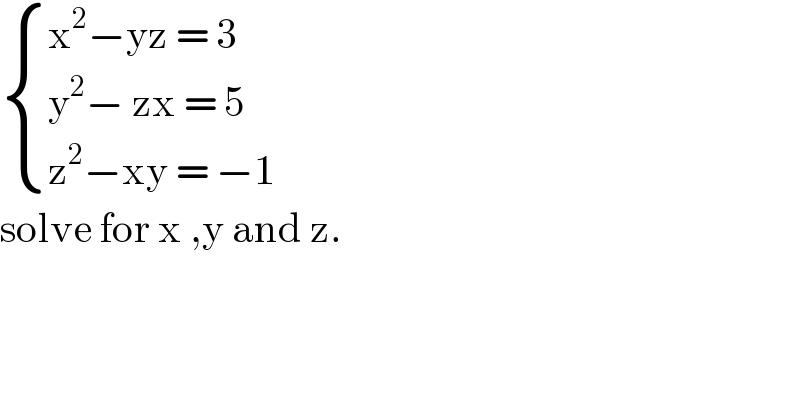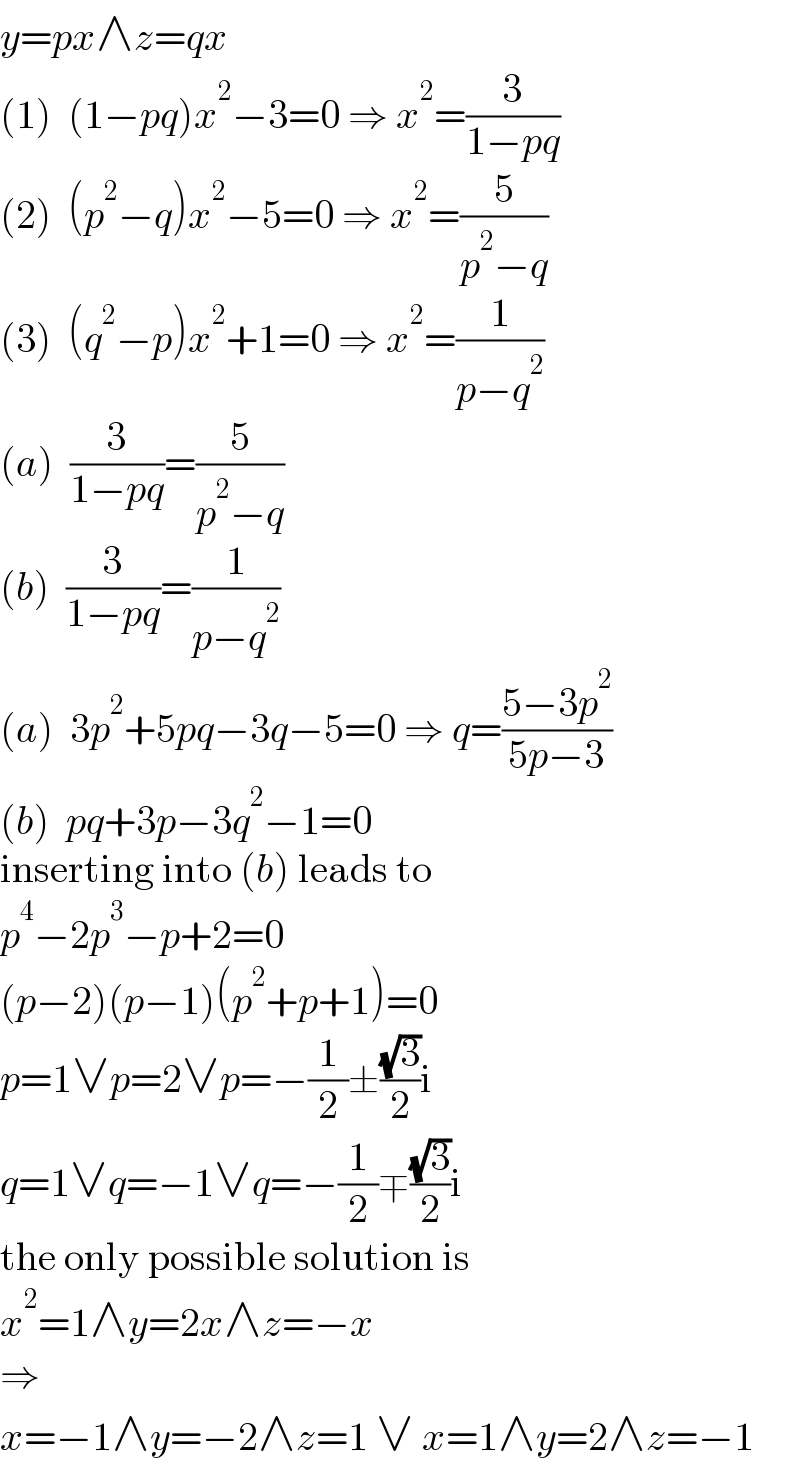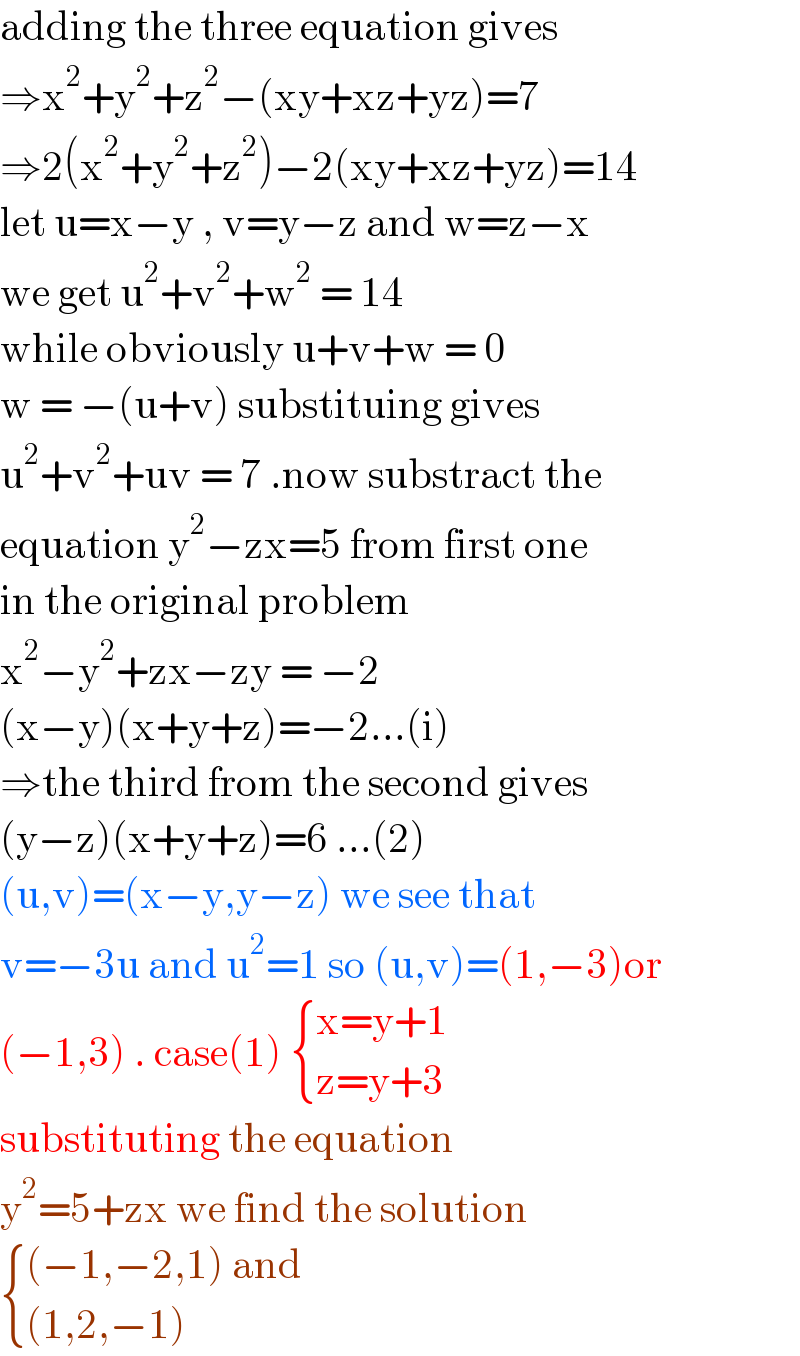Question Number 135191 by liberty last updated on 11/Mar/21

$$\begin{cases}{\mathrm{x}^{\mathrm{2}} −\mathrm{yz}\:=\:\mathrm{3}}\\{\mathrm{y}^{\mathrm{2}} −\:\mathrm{zx}\:=\:\mathrm{5}}\\{\mathrm{z}^{\mathrm{2}} −\mathrm{xy}\:=\:−\mathrm{1}}\end{cases} \\ $$$$\mathrm{solve}\:\mathrm{for}\:\mathrm{x}\:,\mathrm{y}\:\mathrm{and}\:\mathrm{z}. \\ $$
Answered by MJS_new last updated on 11/Mar/21

$${y}={px}\wedge{z}={qx} \\ $$$$\left(\mathrm{1}\right)\:\:\left(\mathrm{1}−{pq}\right){x}^{\mathrm{2}} −\mathrm{3}=\mathrm{0}\:\Rightarrow\:{x}^{\mathrm{2}} =\frac{\mathrm{3}}{\mathrm{1}−{pq}} \\ $$$$\left(\mathrm{2}\right)\:\:\left({p}^{\mathrm{2}} −{q}\right){x}^{\mathrm{2}} −\mathrm{5}=\mathrm{0}\:\Rightarrow\:{x}^{\mathrm{2}} =\frac{\mathrm{5}}{{p}^{\mathrm{2}} −{q}} \\ $$$$\left(\mathrm{3}\right)\:\:\left({q}^{\mathrm{2}} −{p}\right){x}^{\mathrm{2}} +\mathrm{1}=\mathrm{0}\:\Rightarrow\:{x}^{\mathrm{2}} =\frac{\mathrm{1}}{{p}−{q}^{\mathrm{2}} } \\ $$$$\left({a}\right)\:\:\frac{\mathrm{3}}{\mathrm{1}−{pq}}=\frac{\mathrm{5}}{{p}^{\mathrm{2}} −{q}} \\ $$$$\left({b}\right)\:\:\frac{\mathrm{3}}{\mathrm{1}−{pq}}=\frac{\mathrm{1}}{{p}−{q}^{\mathrm{2}} } \\ $$$$\left({a}\right)\:\:\mathrm{3}{p}^{\mathrm{2}} +\mathrm{5}{pq}−\mathrm{3}{q}−\mathrm{5}=\mathrm{0}\:\Rightarrow\:{q}=\frac{\mathrm{5}−\mathrm{3}{p}^{\mathrm{2}} }{\mathrm{5}{p}−\mathrm{3}} \\ $$$$\left({b}\right)\:\:{pq}+\mathrm{3}{p}−\mathrm{3}{q}^{\mathrm{2}} −\mathrm{1}=\mathrm{0} \\ $$$$\mathrm{inserting}\:\mathrm{into}\:\left({b}\right)\:\mathrm{leads}\:\mathrm{to} \\ $$$${p}^{\mathrm{4}} −\mathrm{2}{p}^{\mathrm{3}} −{p}+\mathrm{2}=\mathrm{0} \\ $$$$\left({p}−\mathrm{2}\right)\left({p}−\mathrm{1}\right)\left({p}^{\mathrm{2}} +{p}+\mathrm{1}\right)=\mathrm{0} \\ $$$${p}=\mathrm{1}\vee{p}=\mathrm{2}\vee{p}=−\frac{\mathrm{1}}{\mathrm{2}}\pm\frac{\sqrt{\mathrm{3}}}{\mathrm{2}}\mathrm{i} \\ $$$${q}=\mathrm{1}\vee{q}=−\mathrm{1}\vee{q}=−\frac{\mathrm{1}}{\mathrm{2}}\mp\frac{\sqrt{\mathrm{3}}}{\mathrm{2}}\mathrm{i} \\ $$$$\mathrm{the}\:\mathrm{only}\:\mathrm{possible}\:\mathrm{solution}\:\mathrm{is} \\ $$$${x}^{\mathrm{2}} =\mathrm{1}\wedge{y}=\mathrm{2}{x}\wedge{z}=−{x} \\ $$$$\Rightarrow \\ $$$${x}=−\mathrm{1}\wedge{y}=−\mathrm{2}\wedge{z}=\mathrm{1}\:\vee\:{x}=\mathrm{1}\wedge{y}=\mathrm{2}\wedge{z}=−\mathrm{1} \\ $$
Answered by benjo_mathlover last updated on 11/Mar/21

$$\mathrm{adding}\:\mathrm{the}\:\mathrm{three}\:\mathrm{equation}\:\mathrm{gives} \\ $$$$\Rightarrow\mathrm{x}^{\mathrm{2}} +\mathrm{y}^{\mathrm{2}} +\mathrm{z}^{\mathrm{2}} −\left(\mathrm{xy}+\mathrm{xz}+\mathrm{yz}\right)=\mathrm{7} \\ $$$$\Rightarrow\mathrm{2}\left(\mathrm{x}^{\mathrm{2}} +\mathrm{y}^{\mathrm{2}} +\mathrm{z}^{\mathrm{2}} \right)−\mathrm{2}\left(\mathrm{xy}+\mathrm{xz}+\mathrm{yz}\right)=\mathrm{14} \\ $$$$\mathrm{let}\:\mathrm{u}=\mathrm{x}−\mathrm{y}\:,\:\mathrm{v}=\mathrm{y}−\mathrm{z}\:\mathrm{and}\:\mathrm{w}=\mathrm{z}−\mathrm{x} \\ $$$$\mathrm{we}\:\mathrm{get}\:\mathrm{u}^{\mathrm{2}} +\mathrm{v}^{\mathrm{2}} +\mathrm{w}^{\mathrm{2}} \:=\:\mathrm{14}\: \\ $$$$\mathrm{while}\:\mathrm{obviously}\:\mathrm{u}+\mathrm{v}+\mathrm{w}\:=\:\mathrm{0} \\ $$$$\mathrm{w}\:=\:−\left(\mathrm{u}+\mathrm{v}\right)\:\mathrm{substituing}\:\mathrm{gives} \\ $$$$\mathrm{u}^{\mathrm{2}} +\mathrm{v}^{\mathrm{2}} +\mathrm{uv}\:=\:\mathrm{7}\:.\mathrm{now}\:\mathrm{substract}\:\mathrm{the} \\ $$$$\mathrm{equation}\:\mathrm{y}^{\mathrm{2}} −\mathrm{zx}=\mathrm{5}\:\mathrm{from}\:\mathrm{first}\:\mathrm{one} \\ $$$$\mathrm{in}\:\mathrm{the}\:\mathrm{original}\:\mathrm{problem}\: \\ $$$$\mathrm{x}^{\mathrm{2}} −\mathrm{y}^{\mathrm{2}} +\mathrm{zx}−\mathrm{zy}\:=\:−\mathrm{2} \\ $$$$\left(\mathrm{x}−\mathrm{y}\right)\left(\mathrm{x}+\mathrm{y}+\mathrm{z}\right)=−\mathrm{2}…\left(\mathrm{i}\right) \\ $$$$\Rightarrow\mathrm{the}\:\mathrm{third}\:\mathrm{from}\:\mathrm{the}\:\mathrm{second}\:\mathrm{gives} \\ $$$$\left(\mathrm{y}−\mathrm{z}\right)\left(\mathrm{x}+\mathrm{y}+\mathrm{z}\right)=\mathrm{6}\:…\left(\mathrm{2}\right) \\ $$$$\left(\mathrm{u},\mathrm{v}\right)=\left(\mathrm{x}−\mathrm{y},\mathrm{y}−\mathrm{z}\right)\:\mathrm{we}\:\mathrm{see}\:\mathrm{that}\: \\ $$$$\mathrm{v}=−\mathrm{3u}\:\mathrm{and}\:\mathrm{u}^{\mathrm{2}} =\mathrm{1}\:\mathrm{so}\:\left(\mathrm{u},\mathrm{v}\right)=\left(\mathrm{1},−\mathrm{3}\right)\mathrm{or} \\ $$$$\left(−\mathrm{1},\mathrm{3}\right)\:.\:\mathrm{case}\left(\mathrm{1}\right)\:\begin{cases}{\mathrm{x}=\mathrm{y}+\mathrm{1}}\\{\mathrm{z}=\mathrm{y}+\mathrm{3}}\end{cases} \\ $$$$\mathrm{substituting}\:\mathrm{the}\:\mathrm{equation}\: \\ $$$$\mathrm{y}^{\mathrm{2}} =\mathrm{5}+\mathrm{zx}\:\mathrm{we}\:\mathrm{find}\:\mathrm{the}\:\mathrm{solution}\: \\ $$$$\begin{cases}{\left(−\mathrm{1},−\mathrm{2},\mathrm{1}\right)\:\mathrm{and}}\\{\left(\mathrm{1},\mathrm{2},−\mathrm{1}\right)}\end{cases} \\ $$
